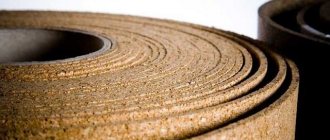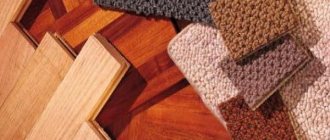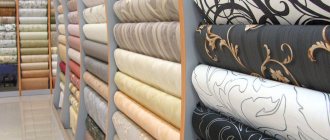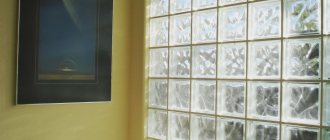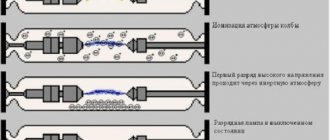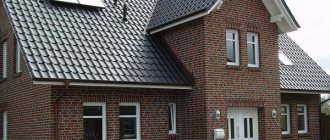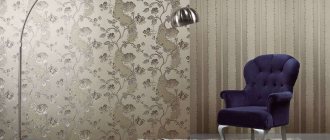Along with the general interest in everything natural and environmentally friendly, in recent years the demand for flooring made from cork tree bark has increased significantly. This material itself does not emit harmful fumes into the environment, and its performance characteristics allow it to be used for finishing floors, walls and even ceilings.
In order to wisely choose a cork floor, the pros and cons of which we will consider further, you should adhere not only to aesthetic preferences, but also to some of the features of the cork flooring itself, as well as restrictions on their use.
Myths about cork floors
Cork is a durable and attractive material for interior decoration. Many people are hesitant to use it after hearing mythical facts. In the table we have collected the most common misconceptions and their refutations.
| Myth | Is it true |
| The coating is rough to the touch | The material is coated with a protective varnish, so it definitely cannot be rough |
| There is only one shade of material | There are a lot of design and color options |
| Cork tiles bend and break easily | This is one of the most common myths. The material is actually dense and hard. |
| The floor has a porous structure, so it is very difficult to clean it | And again we remind you that the products are varnished. The surface can be easily washed from any stains |
The material can be used not only as a floor covering, but also for stylish wall decoration. In the following sections of the article we will discuss in more detail the features of balsa wood products.
Cork floor in the interior
Application area
You can lay cork on the floor in almost any room. Restrictions apply only to those areas where there is a high humidity regime. The products are most in demand when decorating children's rooms. The material will be no less effective when decorating the walls and ceiling of a living room where a “home theater” system is installed.
In addition to residential premises, cork is actively used in public cinemas, children's institutions, hotels, recording studios, offices, etc.
What is cork flooring
Cork covering is a finishing material made from the bark of the cork oak tree. Pressed wood is used to make floor slabs. During the processing of raw materials, resins are released that hold the cork mass together. The natural material is sufficient for fixation, so manufacturers do not need to add glue to the composition. The result is a completely natural coating.
Cork flooring comes in both a natural shade and painted. There are many ideas for design: you can depict original patterns, imitate wood or stone, or mix several colors in the design. A variety of options makes it easy to choose the right coating for any interior style.
Photo printing technologies are actively used to create a unique floor design. Using special equipment, you can apply any print to the material.
Natural cork flooring
Cost formation
The price depends on the design:
- Natural – natural color of cork coated with wear-resistant varnish.
- Painted - tinted to a specific color, the texture is preserved.
- Photo printing - any decor is applied directly to the cork layer: imitation of wood, natural stone, abstractions, thematic designs. Select a cork with photo printing in the catalog.
In addition, the cost depends on the design . Let's look at Corkstyle as an example: Tigre decor is more expensive than Madeira, and Madeira, in turn, is more expensive than Mono. All the models presented in the example are made according to different designs: some are difficult to manufacture, so their prices are higher. But in terms of operational characteristics, the models are absolutely identical .
Types of cork floors
Cork flooring is divided into two types: interlocking and adhesive. They have completely different structures and properties, so let’s focus on the nuances.
Castle floors
Another name for such coatings is cork or floating laminate. The material is produced in the form of slabs or boards, which must be connected to each other with special locks during installation. The clamps are located at the ends of the elements.
The material consists of several layers:
- Substrates.
- HDF or MDF boards.
- Pressed cork.
- Natural veneer or layer with digital photo printing.
- Protective layer: varnish, film or parquet oil.
The average thickness of the panels is 7.5-13.5 mm. Standard element sizes: 20×120, 18.5×90, 30×90 cm.
Interlocking cork floors with HDF or MDF are “afraid” of moisture. Products with hydraulic slabs made of quartz and PVC are considered more waterproof. Such coverings can be installed in the kitchen, but they are not suitable for the bathroom.
Adhesive boards
The adhesive coating consists of only two layers - compressed wood and decorative veneer. This material is available in rolls or slabs of different sizes. The average sheet thickness is 4-6 mm. The elements are not equipped with locks, so they need to be fixed using special glue.
Adhesive cork flooring can withstand changes in temperature and humidity. It does not deform, does not swell, does not rot. That is why designers recommend using the material for installation in rooms with high humidity.
There is another option for adhesive material - boards with a sticky base. The thickness of the element is 3.6-5 mm, the length is no more than 30 cm. This coating is convenient for installation, but requires final treatment with protective compounds.
Cork boards for flooring
Water resistance
An adhesive plug for floors and walls, after laying and treating with polyurethane varnish in 3-5 layers, turns into a durable monolith that is not afraid of high humidity and direct contact with water : in the shower, bathtub, dressing room, around the pool, with the exception of steam rooms. At the same time, the surface of the cork floor has an anti-slip effect.
Adhesive cork, as well as interlocking cork laminate on a HYDRO basis, can withstand flooding of any scale without any consequences!
Cork flooring: pros and cons
Attractive appearance and warm surface are the main arguments for environmentally friendly coating. Let's consider other advantages of cork flooring:
- Naturalness: the cork coating does not contain polyvinyl chloride, formaldehyde, phthalates and other chemical components.
- Hypoallergenic: the coating does not contain toxic substances, therefore it is absolutely safe for health.
- Ease of installation: laying the floor is easy to do without the help of specialists.
- Resistance to deformation: the cork surface quickly restores its shape after mechanical stress.
- Durability: the minimum service life of the coating is 10 years.
- Fire resistance: the material does not flare up from an open flame.
- Pleasant texture: the coating springs easily underfoot, so it’s pleasant to walk on it even barefoot.
- High thermal conductivity: cork flooring helps maintain an optimal microclimate in the rooms.
Let's move on to the disadvantages. A high-quality cork coating has only two objective disadvantages:
- High price: such a floor is more expensive than linoleum and some other types of coatings, but the quality of the material will definitely not disappoint.
- The need for careful preparation of the subfloor: the coating can only be laid on a perfectly flat surface.
Important! Cork material is damaged as a result of exposure to sharp objects. Try not to drop knives, forks, or toys with protruding elements on it.
Cork floor design example
Rules for caring for cork flooring
Many people think that cork floors are difficult to maintain. In fact, it is enough to follow a few cleaning rules:
- To get rid of dust, just use a vacuum cleaner. For processing the adhesive coating, a detergent is suitable, for a lock coating - a regular one.
- If you don't have a vacuum cleaner, you can carefully sweep the floor and wipe it with a slightly damp cloth.
- If a substance that leaves stains comes into contact with the flooring, immediately clean the floor with a damp cloth and a mild detergent.
- Periodically check the integrity of the protective layer. If the varnish is scratched or worn out, recoat the floor. For processing, choose special compounds recommended by the coating manufacturer.
- Do not use powders or aggressive liquid products to care for the coating - they will damage the cork surface.
- To clean the adhesive cork material, you can use a steam mop without sharp elements on the nozzles.
Advice! The most thorough cleaning of cork flooring is required on the balcony and in the hallway. To minimize contamination, place rugs on the floor.
Flaws
Possible swelling of seams
May swell in high humidity. The reason is that the laminate is based on MDF, and it is not resistant to direct water flows. There is an option to apply varnish on top, but then you will have to do this constantly, and from a surface that is regularly exposed to stress, the varnish will peel off faster.
Deformation from severe dents
No deformation - does not concern strong dents that can be left by a hammer falling on the floor. Similar dents remain on wooden floors.
Roughness
Inconveniences may also be associated with the rough texture. In production, the material can be coated with different compounds for better smoothness and aesthetics. But sometimes roughness interferes - for example, it wears out the soles of house shoes or socks.
In general, as with any material, everything is relative. There are clear advantages that can immediately motivate you to buy and install it in your apartment. But against the advantages there are also disadvantages, and they cannot be ignored.
Instagram @parket_kazan
Instagram @parket_kazan
Cork floor installation
Laying interlocking material and self-adhesive tiles will not cause any difficulties. Therefore, we will analyze in detail the technology of working with adhesive cork coating.
Materials:
- Solutions for leveling the subfloor.
- Primer composition.
- Polymer glue.
- Large brush or roller for applying glue.
- Pencil for marking.
- Roulette, level.
- Mallet.
- Cloth to remove excess glue.
Before starting work, make sure that there is no draft in the room. Check the air temperature - it should be in the range of 18-25 °C. If possible, measure the humidity level. Ideal figures are 55-65%.
Let's move on to the installation algorithm. Repair work consists of three large stages:
- Preparation for installation. To ensure a smooth cork floor, the base must be thoroughly cleaned, sanded and primed. If you neglect this stage, defects will appear on the finishing coating.
- Marking the base. After preparing the subfloor and primer, you need to draw lines relative to which you will lay out the cork slabs.
- Gluing the coating. It is better to start the installation process from the center of the room to the walls. You can mount the elements in a checkerboard pattern or in parallel with a slight offset. The adhesive must be applied to the underside of the slabs and the subfloor. Excess composition should be removed immediately, otherwise it will be noticeable on the surface. After applying the glue, you need to press the coating tightly to the floor, then roll it with a mallet.
Advice! Glue the elements end to end. The gaps between the slabs will be difficult to decorate, so it is better to act carefully right away.
Cork floor installation process
Cork covering and “warm floor” system
Let's look at another important issue - the compatibility of warm and cork floors. Material manufacturers are confident that making such a “pie” is impractical. Cork already has high thermal insulation, so there is no point in additional heating. A few more arguments against the union of materials:
- Risk of deformation of the cork coating when heated above 28 °C.
- The need for thermal insulation of floors.
- Large heat losses due to prolonged heating of the plug.
There is only one argument for it - the lack of heating in the room. A combination of systems is often found on balconies or loggias. If you are also inclined to combine cork flooring and “warm floor”, study the manufacturers’ recommendations.
Warm floor under cork covering
Cork flooring in the interior of rooms
The material is suitable for finishing the floor in almost all rooms. The exception is home saunas and swimming pools, because they are too warm and humid. Let's talk about the benefits of cork covering for each room.
Children's
A children's room is the best place for cork flooring. Firstly, the material will not harm the child’s health. Secondly, the elastic surface minimizes the risk of injury to children during play.
Another factor of choice is the excellent soundproofing properties of the material. The coating perfectly absorbs sounds, so other inhabitants of the house will not be disturbed by children's fun.
Cork flooring in the nursery
Balcony
The main requirement for balcony flooring is the ability to retain heat. Cork copes with this task perfectly. Look how harmonious a natural and beautiful floor looks in a modern balcony interior.
Cork flooring on the balcony
Bedroom
Cork covering in the bedroom gives comfort and a feeling of unity with nature. A nice bonus is that this floor does not creak even after many years of use. This means that the steps of household members will not interfere with your restful sleep.
Cork flooring in the bedroom
Living room
The natural texture of cork will fit perfectly into any interior style. If you are looking for a versatile living room flooring option, this is the best option. The material looks interesting, but does not distract attention from other details of the decor. The photo shows an example of a successful living room interior with cork flooring.
Advice! In addition to cork flooring, you can create a stylish wooden ceiling in your living room.
Cork flooring in the living room
Hallway
The hallway needs a wear-resistant and warm floor covering. Cork has these qualities, so it is suitable for finishing. You can choose any type of material and design to suit your interior style.
Cork flooring in the hallway
Bathroom
The bathroom is not an ideal location for natural materials, but don’t rush to give up the idea of making a cork floor there. Design Tips:
- Choose an adhesive type material.
- Cover the floor surface with an additional layer of varnish.
- Renew the protective layer regularly.
When installing the material, carefully check the joints between the elements. If there are gaps, moisture will penetrate there and ruin the coating. Pay special attention to areas near the bathtub, sink, shower stall.
Cork flooring in the bathroom
Kitchen
The kitchen is a room with an unstable microclimate, so you need to take responsibility for the decoration. Tips for choosing cork flooring:
- It is better to give preference to an adhesive type coating - it has water-repellent properties.
- If you prefer a castle-type material, opt for a coating with a hydroslab base.
- For the kitchen, a floor design inspired by wood, marble, or ceramics is suitable.
Cork flooring for kitchens is popular due to the fact that it is practically non-slip. This property often saves housewives from serious injuries. For example, when washing dishes, water often gets on the floor. As a result, puddles appear that are easy to slip on. If the kitchen has laminate, parquet or linoleum, you can fall and get injured. With cork flooring this is much less likely.
Another useful quality of the material is its elastic surface. If you accidentally drop a plate or cup on the floor, the dishes will most likely survive.
Cork flooring in the kitchen
